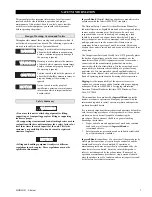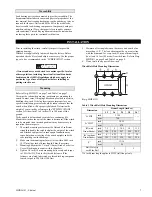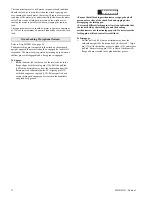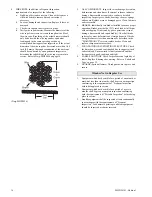
MHD56181 - Edition 1
11
OPERATION
The four most important aspects of winch operation are:
1.
Follow all safety instructions when operating the winch.
2.
Allow only people trained in safety and operation of this
winch to operate this equipment.
3.
Subject each winch to a regular inspection and maintenance
procedure.
4.
Be aware of the winch capacity and weight of load at all
times.
WARNING
• The winch is not designed or suitable for lifting, lowering or
moving people. Never lift loads over people.
CAUTION
• To avoid damage to the rigging, the structure supporting the
rigging and the winch, do not “two-block”* the end of the wire
rope.
* Two blocking occurs when the winch wire rope is multi-reeved
using two separate blocks which are allowed to come in contact
with each other during winch operation. When this occurs,
extreme forces are exerted on the wire rope and sheave blocks
which may result in equipment and/or rigging failure.
Operators must be physically competent. Operators must have no
health condition which might affect their ability to act, and they
must have good hearing, vision and depth perception. The winch
operator must be carefully instructed in his duties and must
understand the operation of the winch, including a study of the
manufacturer’s literature. The operator must thoroughly
understand proper methods of hitching loads and should have a
good attitude regarding safety. It is the operator’s responsibility to
refuse to operate the winch under unsafe conditions.
Hydraulic System
Efficient operation of the winch requires attention to the hydraulic
oil system. The most important elements to ensure proper
operation of the hydraulic system are:
1.
Oil Temperature. The presence of hot fluid in a hydraulic
system is a primary cause of poor operation, component
failure and system downtime. The fluid used in any
hydraulic system is formulated for operation within a
temperature range of 32° to 140° F (0° to 60° C). If the
temperature is frequently exceeded component and system
operation will be degraded.
Under continuous operating conditions the temperature of
the oil at any given point in the hydraulic system should not
be allowed to exceed 180° F (82° C).
2.
Oil Cleanliness. Hydraulic system cleanliness is extremely
important to ensure safe, continued operation of components.
Dirty or contaminated hydraulic fluid may cause components
to break down, operate erratically or damage valuable
equipment.
Warm Up Procedure
CAUTION
• A warm up procedure is recommended at each start-up
under normal operating conditions, and is essential at ambient
temperatures below 40° F (4° C).
To warm up the hydraulic oil and system, run the pump with the
winch control valve in neutral long enough to sufficiently warm
up the system.
Once the system has warmed up, operate the winch, without a
load, at slow speeds in both directions several times to prime all
lines with warm hydraulic fluid.
Winch Controls
Ensure control valve handle movement is consistent with
direction of winch drum rotation. Refer to manufacturer’s
literature for additional information.
Winch Brakes
Manual Drum Brake (optional feature)
Refer to Dwg. MHP0153 on page 28.
The manual drum brake may be applied by pushing down on the
handle (104) and released by pulling up. If the handle is pushed
down fully, it should lock in that position and prevent drum
rotation, until released by the operator. The brake must be kept
properly adjusted to hold the required load. Refer to the
“MAINTENANCE” section for adjustment instructions.
Automatic Drum Brake (optional feature)
Refer to Dwg. MHP0153 on page 28.
The automatic drum brake is a spring applied, oil released brake
which utilizes an oil actuated, spring loaded cylinder (110), that
automatically disengages the brake when the motor is operated.
Oil pressure in the cylinder overcomes spring pressure to release
the brake. When the control valve is placed in the neutral position,
the oil in the cylinder (110) drains to tank and the spring
automatically engages the brake to prevent drum rotation.
The cylinder clevis (107) must be kept properly adjusted to hold
the required load.
Automatic Disc Brake
The winch brake typically consists of a fail-safe disc brake and a
counterbalance valve. The brake is disengaged in the lowering
(payout) direction only. In the raise (haul-in) direction, the brake
remains engaged, and an internal sprag clutch provides fail-safe
load lifting, preventing momentary downward load drifting at the
instant the winch control valve (refer to manufacturer’s
information) is shifted to raise the load. The brake release oil
pressure is provided by fluid pressure ported from the winch
motor to the brake housing.






































